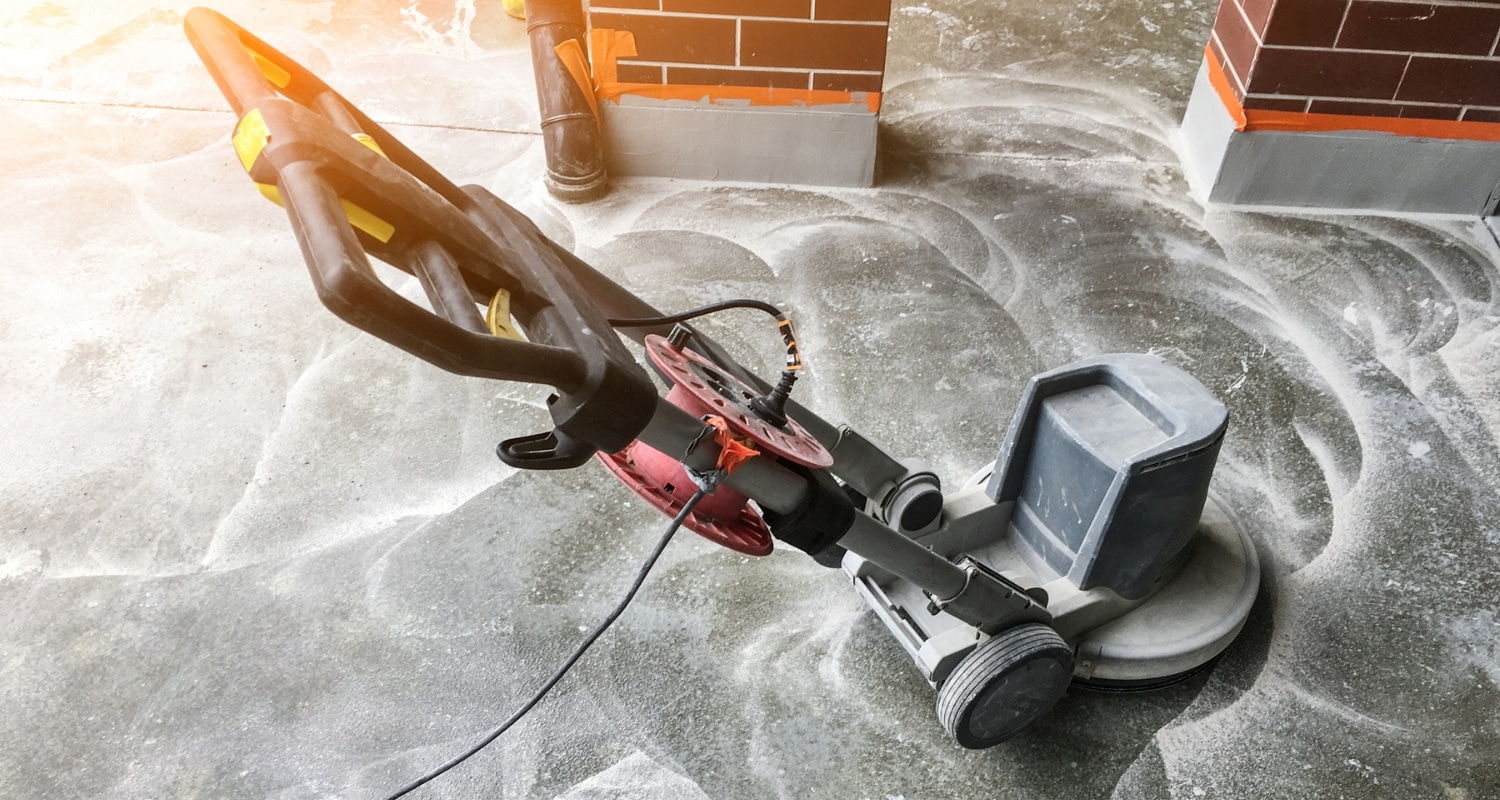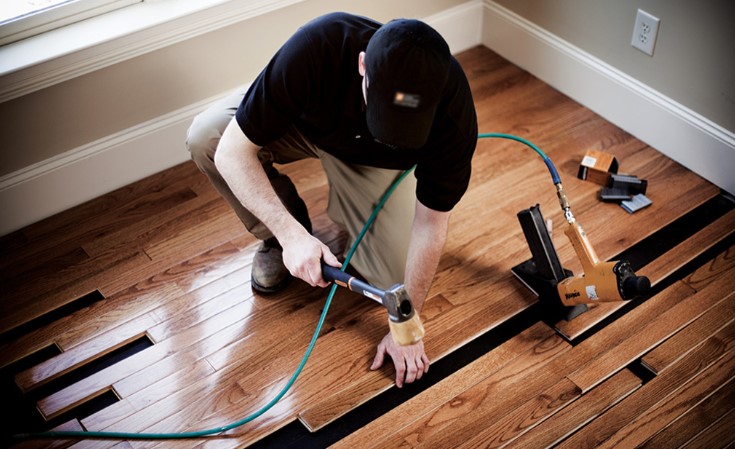A DIY Guide By The Pros

Sanding concrete can be intimidating, but with the right tools and techniques, you’ll be sanding like a pro in no time. This blog post will walk you through the key steps for sanding concrete in a DIY project.
We’ll cover the different types of sandpaper and sanders, tips for creating the perfect sanding surface, and steps to sand concrete floors, patios, walls, or countertops. With our expert advice, sanding your concrete will be a breeze.
Why People Sand Concrete
Concrete is a versatile material used in everything from driveways to countertops. However, it isn’t always the most visually appealing material. Fortunately, there are several ways to improve the appearance of concrete with sanding and polishing.
Let’s look at some of these techniques and how they can help you achieve better results for your concrete projects.
Improved Appearance
One of the most common reasons for sanding and polishing concrete is to improve its overall appearance. By using abrasive materials such as diamond pads or sandpaper, you can remove any imperfections that may have occurred during the pouring process.
This will give your concrete surface a smoother, more uniform look. Additionally, buffing out uneven surfaces can reduce staining caused by water or other liquids seeping into the material over time.
Smoothing or Polishing
In addition to enhancing the overall appearance of your concrete surfaces, sanding and polishing can also be used to create a smoother finish that feels great underfoot.
Using an orbital sander or other power tools equipped with diamond-encrusted wheels can quickly smooth out any roughness in your concrete surface while creating a polished sheen that adds visual appeal and increased durability against wear and tear over time.
Exposed Aggregate
Another popular technique for enhancing concrete is exposing aggregate – small pieces of stone, glass, gravel, or other elements found naturally in many rock types – for an attractive textured look on outdoor patios or walkways.
To expose aggregate underneath a layer of smooth concrete, contractors use special grinding tools designed specifically for this purpose.
Grinding away the top layer will reveal the colorful aggregates underneath, which can be further enhanced with additional sanding and polishing if desired.
Repair Old Concrete Quickly and Easily
Sanding concrete is an excellent option for repairing old or damaged concrete surfaces. Using special tools like grinders or sanders, you can quickly smooth down any imperfections in your concrete floor or wall so that it looks like new again.
This process also eliminates the need to replace cracked or chipped sections of concrete, saving you time and money in the long run.
Remove Rough or Hazardous Edges
If you have sharp edges on your concrete surface, sanding them down is the quickest way to make them safe again.
Whether you need to smooth out some jagged edges around your patio or pool deck or ensure that your walkway isn’t causing any trips or falls, sanding can help create a much safer environment for everyone using it.
Remove Old Paint, Stains, or Coatings
It’s not uncommon for paint and other coatings to wear off over time due to weather conditions and normal wear-and-tear.
Sanding can help remove these unwanted layers quickly without damaging everything with harsh chemicals. This ensures that the job is done safely without damaging the underlying material.
Sanding concrete is a necessary step for many DIY and professional projects. Whether refinishing an existing floor or completing a brand-new project, sanding is essential to the concrete preparation process.
However, to ensure your project turns out as intended, you’ll need to select the right tools and methods for the job. Here are a few tools you can use for your project.
Hand Sanding Concrete
Hand sanding requires hard work and patience but is often preferred by DIY-ers who enjoy the challenge of a complex project. Hand sanding should always be done with a dust mask to minimize inhalation of silica particles.
To begin hand-sanding, you will need 80-100 grit sandpaper and a sandpaper block. Begin by wetting the sandpaper and the concrete area you’re working on before applying moderate pressure in smooth strokes back and forth across the surface.
After completing one section, move on to the next until all areas are complete.
Orbital Sander
An orbital sander is perfect for larger jobs requiring more power than hand-sanding provides. An orbital sander works by vibrating in small circles, which helps remove material quickly without creating divots or gouges in the concrete surface.
Orbital Sanders come in both electric and cordless varieties and can be used with 80-220 grit paper, depending on how aggressive you want your finish to be. Keep it moving when using an orbital sander so that it doesn’t create any deep scratches or dips in your paint job!
Belt Sander
The belt sander is another powerful tool perfect for tackling large sanding projects and removing old paint from surfaces before repainting them. Belt sanders require 120-180 grit paper for optimal results, as this will provide an even finish without leaving any deep scratches or imperfections behind.
To safely use a belt sander, ensure that you wear protective eyewear (goggles) and ear protection due to the loud noise these machines generate when they’re turned on!
Additionally, hold the belt sander firmly while operating it so that it does not slip out of your hands during use which could cause serious injury.
Angle Grinder
For small-scale sanding projects, angle grinders are a great choice. These handheld tools allow you to easily maneuver around tight corners, making them ideal for small projects such as grinding down tiles or cleaning up rough edges on countertops.
They also come in cordless models that can be used outdoors without worrying about finding an outlet. As with any tool, it’s essential to take safety precautions when using angle grinders; always wear protective gear such as goggles or face shields when operating one.
Floor Concrete Grinder
When it comes to large-scale sanding projects like refinishing floors or removing paint from large surfaces, nothing beats a floor concrete grinder.
These powerful machines use diamond abrasive disks that quickly remove material from the surface of the concrete while minimizing dust and debris.
Unlike angle grinders that must be manually moved around the surface of the concrete, floor grinders can cover large areas quickly and efficiently, saving you time and energy in the long run.
However, it’s important to note that these machines require more skill than other types of grinders; if you’re unfamiliar with how they work, it’s best to consult a professional before attempting this type of task.
Choosing the Right Sandpaper To Sand Concrete
When sanding concrete, the type of sandpaper used is critical. Many people overlook this step, which can lead to a suboptimal final result.
For example, if you’re sanding an unfinished concrete floor, start with a 40-60 grit sandpaper and work your way up to the finer grades, such as 80-120 or 200-400.
Inspect the area afterward and select the correct grade based on the amount of sanding still required.
Additionally, consider choosing an abrasive material designed for use with your specific power tool to ensure that you achieve maximum precision and bring about an excellent finish as quickly as safely possible.
What Is Best for Sanding Concrete?
A good choice when sanding concrete is an orbital sander. This powerful tool puts out a smooth finish while simultaneously saving time and effort. If you’re looking to sleeker up a kitchen counter or a stairwell fixture, an orbital sander can give you the perfect glow in no time.
Just be sure to pick up something heftier if you plan on tackling a whole concrete floor, as their smaller faces may not be enough for larger projects like these.
8 Steps To Sand Concrete Floors, Patios, Walls, or Countertops
Sanding concrete walls, floors, patios, or countertops is an easy and affordable way to transform the look of any space without the need for costly renovations. Here’s your step-by-step guide on how to sand concrete in 8 simple steps!
Step 1. Prepare the Area and Yourself
Before starting to sand concrete, it is essential to take a few steps to ensure the project goes smoothly. The first step is to prepare the area where the sanding will occur properly. Clean up any debris and do any necessary repairs before beginning.
Before beginning, you should also protect yourself with coveralls, a respirator, goggles, and ear protection. Make sure you are working in an open area with plenty of ventilation.
Once these safety precautions have been taken care of, begin sanding your concrete floors, patios, walls, or countertops so you can eventually achieve the desired outcome.
Step 2: Inspect and Make Repairs as Needed
Once you have everything prepared and ready to go, inspect the condition of the concrete thoroughly and repair any cracks, chips, or other minor imperfections.
Fortunately, these repairs can generally be made relatively quickly by using an appropriate compound such as epoxy or masonry sealant.
Doing so will help ensure that all of the cracks are filled and ultimately yield a smoother, more professional finish after the sanding process is complete.
Furthermore, in addition to inspecting for surface problems, it’s crucial to determine if any obtrusive objects, such as nails or screws, are embedded within the concrete that could potentially cause damage to sanding equipment.
These precautionary steps will help sand down concrete floors, patios, walls, or countertops more easily while producing a beautiful finished result that won’t need immediate repairs.
Step 3: Choose Method and Tools
Once you have determined that a sand concrete finish is best for the space and it is sufficiently prepped, you will need to select the method of processing and tools that are suitable for the job.
There are three primary methods used to sand concrete walls:
Each method has its advantages and disadvantages depending on the extent of work you plan to accomplish.
In terms of tools, those used for sanded concrete surfaces can range from rotary grinders and polishers to more handheld options like angle grinders, chisels, and angle disks. Regardless of which tool you choose, be sure to wear appropriate safety gear, such as goggles and a dust mask, when working with these products.
Step 4: Choose Your Sandpaper
After completing the first three steps to sand concrete, the next step is choosing your sandpaper. Different levels of grit are available depending on your desired result.
Grit number plays an important role when it comes to sanding concrete as lower numbers offer more aggressive removal while higher numbers are more suitable for polishing surfaces.
Consider the type of project and determine if you’re looking for a more aggressive or less abrasive approach before selecting your sandpaper choice.
Choosing the correct type of sandpaper can save considerable time and money in the long run, so take some time to understand the options to select the best one for your project.
Step 5: Start Sanding the Concrete
Now that all your preparations have been made, it’s time to start! Begin at one end of the surface area that needs sanding.
Then, gradually work your way across in straight lines until you have covered all areas that need attention, ensuring even coverage as much as possible throughout each pass over the surface area being worked on.
Be sure not to press too hard with your sander/grinder, as this could cause damage or uneven results on the finished product once complete!
Step 6: Apply a Hardener
The sixth step to sand concrete floors, patios, walls, or countertops is applying a hardener. A hardener is a crucial step to ensure good results and durability.
The hardener will further strengthen the concrete by providing a more solid foundation – creating a durable surface resistant to scratches, and wear and tear effects.
It’s crucial that you use a good quality hardener and follow the manufacturer’s instructions carefully to achieve the best results. Make sure to read all safety procedures before starting your project.
After the hardener has been applied and given enough time to dry, it’s time for the next step: polishing.
Step 7: Polish Concrete
Once all of the previous steps have been completed, polishing concrete brings out the shine of the project.
A floor grinder is typically used on larger surfaces and can be expensive to rent or buy – a wet diamond polisher is best suited for medium and smaller areas that require finer detail. This vital step ensures there are no loose particles making it safe to walk on or touch.
After the polishing has been finished, sealers can then be applied to re-establish elements like glossiness and stain protection.
Depending on the finish desired, a professional should be consulted to choose the right type of sealer with the proper application process, including wiping down any dirt after polishing before applying a thin coat.
Step 8: Apply a Sealant
The final step to finishing up your concrete project is the easiest – apply sealant! By sealing your product, you’ll protect it from moisture and traffic that could potentially wear down its appearance over time.
This will ensure that it remains to look as beautiful as when you first poured the concrete. When deciding which sealant to choose for your project, look for ones specifically made for outdoor use since they are specially formulated to withstand weather conditions.
Make sure to read up on the best way to apply the sealant properly and evenly before beginning to prevent uneven results or further water damage down the line.
With these simple steps and precautions, your new concrete floors, patios, walls, or countertops will look perfect for years to come!
Pro Tips
If you’re looking to sand concrete, there are some essential tips and tricks that you should know.
The most crucial tip for sanding concrete is to take your time. Rushing through the process will only result in an uneven finish and could even cause damage to the concrete surface.
When sanding high spots in concrete, use a spirit level or straight edge to ensure that you are not sanding too much. This is a great way to be cautious and prevent ruining the surface of your concrete.
If wet sanding concrete, wash or wipe away the cement and water slurry with your sander or grinder after each pass. Allowing this slurry to dry can cause it to harden and become difficult to remove without sanding it all over again.
It’s also important to note that if you’re attempting to level a large concrete floor surface, renting a heavy-duty floor sander from your local home improvement store may be necessary instead of using handheld tools like belt grinders or orbital sanders.
Hiring an expert with access to these machines is also possible if you don’t feel comfortable doing it yourself.
Prepare the surface by cleaning it with a broom or vacuum. This will help remove any dirt or debris from the surface which can cause scratches when sanding. Once the surface is clean, use a damp cloth to wipe away any remaining residue before moving on to the next step.
Applying sealant after sanding is essential to protect your surface from wear and tear and stains. Make sure you choose a sealant explicitly designed for concrete surfaces and follow all instructions carefully when applying it.
Allow the sealant time to dry completely before using or touching your newly finished surface.
Frequently Asked Questions
The following are some of the most frequently asked questions about sanding concrete.
It sure can be done if you need to sand or smooth out a concrete surface! However, unless you have the right tools and skills, expect it to take some time. Wet or dry sandpaper will do the job, but don’t expect perfect results.
If you want a perfectly smooth finish, your best bet is to invest in one of the many concrete sanders available on the market. The sander types vary greatly, and most home improvement stores stock them, making them easy to get hold of.
Rough or bumpy concrete can be smoothed if you use the right tools and techniques. An orbital sander is usually sufficient to achieve the desired results.
Still, careful consideration must be taken when selecting your grit – 40 to 60 grit may deliver the desired results when smoothing out resilient concrete with few imperfections.
More worn-out and distorted surfaces may require more intensive measures, such as a concrete grinder with a higher grit, depending on the texture you’re aiming for. Don’t underestimate the importance of picking the right equipment to attain a smooth outcome.
Sanding concrete can seem intimidating due to the tough nature of the material, but it’s not as difficult as it may seem. With the right tools – in this case, diamond grinding wheels and diamond polishing pads – sanding concrete is possible and relatively easy.
Of course, you should always wear a mask and proper safety gear, as concrete can create dust which can be dangerous if inhaled or ingested. Despite its hardness, concrete lends itself well to sanding with the correct abrasives.
When dealing with concrete, the finishing process can make all the difference–and when it comes to sanding concrete, sealing is essential.
It gives the concrete a smooth, finished look and provides a protective barrier that helps guard against regular wear and tear, spills, and stains.
However, this doesn’t mean you can just slap on any sealant and call it a day; for best results, apply one to two coats of quality concrete sealant after completing the sanding process. Doing so will ensure that your newly sanded surface looks great and stands strong for years to come.
Sanding concrete is possible, although regular sandpaper won’t be enough to complete the job. Ceramic and aluminum oxide can help create a smooth finish, but it will require a longer amount of time and more effort.
If you’re looking for a better way to sand your concrete surface, consider using diamond sanding or polishing pads. These tools are specifically designed for the task and have many advantages that make the process simpler and more efficient.
Moreover, they can often achieve a higher quality of finish compared to other options available.
Sanding a concrete surface by hand is possible, although the task may require effort. Diamond polishing pads are particularly effective for this application since their hardy diamond-encrusted surface is highly resistant to wear, allowing them to cut through tough concrete.
To get the highest quality results, it’s recommended to start with coarse grit and then lessen the size of the abrasive particles until you reach the fine grits desired.
Conclusion
Sanding concrete is not as difficult as it may seem, and with the right tools, you can achieve a smooth finish. However, it is important to remember that sealing your newly sanded surface is essential to prevent wear and tear or spills from damaging the surface.
Therefore, before starting any concrete project, ensure you have all the necessary supplies, such as diamond grinding wheels and polishing pads. With these tips in mind, you’ll be able to confidently tackle any task related to sanding concrete surfaces and create beautiful results!








